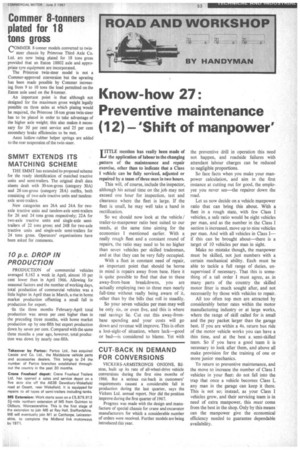Know-how 27: Preventive maintenance (12) 'Shift of manpower'
Page 55

If you've noticed an error in this article please click here to report it so we can fix it.
TITTLE mention has really been made of 1–d the application of labour to the changing pattern of the maintenance and repair exercise, other than to indicate that a Class I vehicle can be fully serviced, adjusted or repaired by a team of three men in two hours.
This will, of course, include the inspector, although his actual time on the job may not exceed one hour for inspection, test and clearance where the fleet is large. If the fleet is small, he may well take a hand in rectification.
So we should now look at the vehicle / trailer-to-manpower ratio best suited to our needs, at the same time aiming for the economies I mentioned earlier. With a really rough fleet and a constant round of repairs, the ratio may need to be no higher than seven vehicles per skilled tradesman, and at that they can be very fully occupied.
With a fleet in constant need of repair, an important point that should be borne in mind is repairs away from base. Here it is quite possible to find that due to these away-from-base breakdowns, you are actually employing two to three men nearly full-time without really being aware of it, other than by the bills that roll in steadily.
So your seven vehicles per man may well be only six, or even five, and this is where real savings lie, Cut out this away-frombase spending and your costs will go down and revenue will improve. This is often a lost-sight-of situation, where luck—good or bad—is considered to blame. Yet with the preventive drill in operation this need not happen, and roadside failures with attendant labour charges can be reduced to negligible proportions.
So face facts when you make your manpower calculation, and aim in the first instance at cutting out for good, the employee you never see—the repairer down the road.
Let us now decide on a vehicle manpower ratio that can bring this about. With a fleet in a rough state, with few Class I vehicles, a safe ratio would be eight vehicles per man, and as the number in the Class I section is increased, move up to nine vehicles per man. And with all vehicles in Class I— if this can be brought about—there is a target of 10 vehicles per man in sight.
Make no mistake though, the manpower must be skilled, not just numbers with a certain mechanical ability. Each must be able to tackle a full range of duties, unsupervised if necessary. That this is something of a tall order I must agree, as . in many parts of the country the skilled motor fitter is much sought after, and not necessarily by those with vehicles to repair.
All too often top men are attracted by considerably better rates within the motor manufacturing industry or at large works, where the range of skill called for is small and the pay packet larger than the garage best. If you are within a 4s. return bus ride of the motor vehicle works you can have a thin time, and at the best a. semi-skilled team. So if you have a good team it is necessary to look after them, and above all make provision for the training of one or more junior mechanics.
To return to preventive maintenance, and the move to increase the number of Class I vehicles in your fleet: do not fall into the trap that once a vehicle becomes Class I, any man in the garage can keep it there. This is not so; instead, as your Class I vehicles grow, and their servicing team is in need of extra manpower, this must come from the best in the shop. Only by this means ' can the manpower give the economical efficiency needed to guarantee dependable availability.




























































































































































